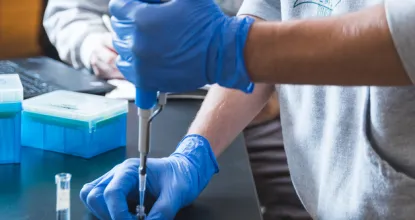Most of the faculty in the Chemistry Department have on-going research projects and welcome student researchers. You can obtain chemistry credit for your research work through courses such as CH 297 and 298 for freshman and sophomores and also CH 490 and 491 for juniors and seniors .
Research interests of faculty are listed below. For more details about a particular faculty member’s research projects check out faculty web sites on the faculty listing page.
Robin Bond—environmental chemistry—tracing contaminants in air and water, linking nutrient cycling to microbiome; astrobiology—finding links between geochemistry and microbiology to help predict what life might be found on Mars & Europa.
Brandon Canfield—medicinal plant chemistry, environmental/analytical chemistry, separation and analysis of plant secondary metabolites and their response as a function of environmental stressors, cannabinoid decarboxylation and decomposition kinetics.
Hannah Cavalieri—analytical chemistry, detection of heavy metals in soil and phytoremediation of heavy metals in hemp plant material, forensic chemistry, gunshot residue characterization during decomposition studies and environmental studies
Maris Cinelli—medicinal plant chemistry, using mass spectrometry to profile plant metabolites and discover new natural products with possible future drug potential. Analytical chemistry of plant-insect interactions.
Yu (Leo) Liu—organic chemistry, synthesis of nano-device based catalytic systems, new cooperative catalysts development and catalytic reaction mechanism studies.
Don Marquardt—organic chemistry, synthesis of novel aromatic compounds such as fullerenes, free radical chemistry.
Frankie McCormick—organic chemistry, synthesis of compounds with novel electronic properties and radical chemistry synthetic methods.
Kathryn Newton—inorganic chemistry, materials chemistry, microwave-assisted synthesis of metal oxide semiconductor nanomaterials, characterization of nanomaterials, photocatalytic degradation of environmental pollutants.
Mark Paulsen—physical and biochemistry/theoretical chemistry, computer modeling of enzymatic reactions and protein-protein interactions.
Evan Pratt—the design, development and application of fluorescent sensors to study cellular metals and key metabolites in live mammalian cells.
Lesley Putman—plant biochemistry, phytoremediation of PFAS using hemp.
Lee Roecker—inorganic chemistry, synthesis and reactivity of colbalt (III) compounds coordinated by thiourea or thioether ligands.
Alex Wilson—specialized metabolism of medicinal plants, structural changes in enzymes cause change in function, uridine diphosphate (UDP) dependent glycosyltransferases (UGTs) and shikimate dehydrogenases (SDHs).
Philip Yangyuoru—bioanalytical chemistry, biosensors, chemical sparations, and forensic biochemistry—forensics and trace analysis of heavy metals in food, water, biological and environmental samples—forensic toxicology and analysis of medicinal plant drug candidates—develop high-throughput methods for probing noncanonical nucleic acid secondary structures especially G-quadruplexes and i-motifs—design nucleic acid-based biosensors for drug molecules, including HPLC-MS methods for proteins and ligand binding, and for detecting biomarkers of biological and environmental concern—enzyme kinetics assays and mechanisms by which helicase proteins manipulate nucleic acid structures.
